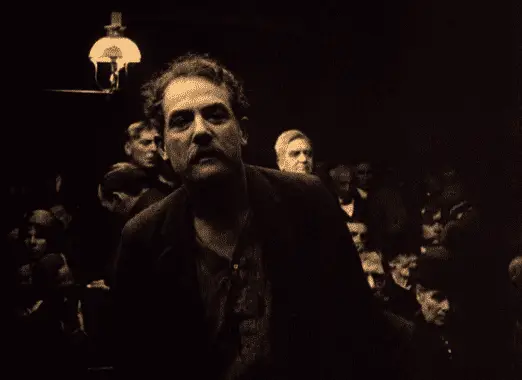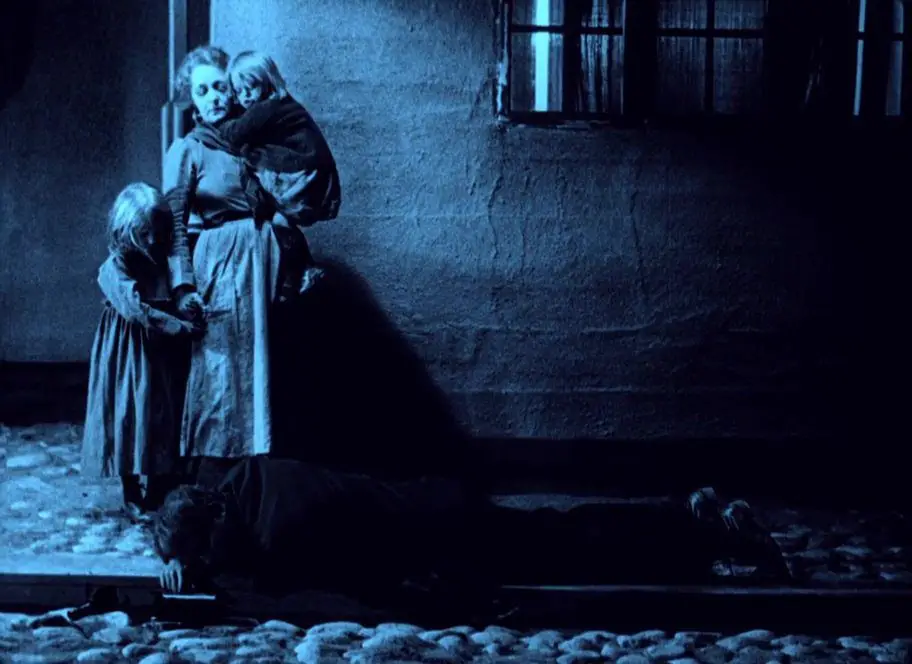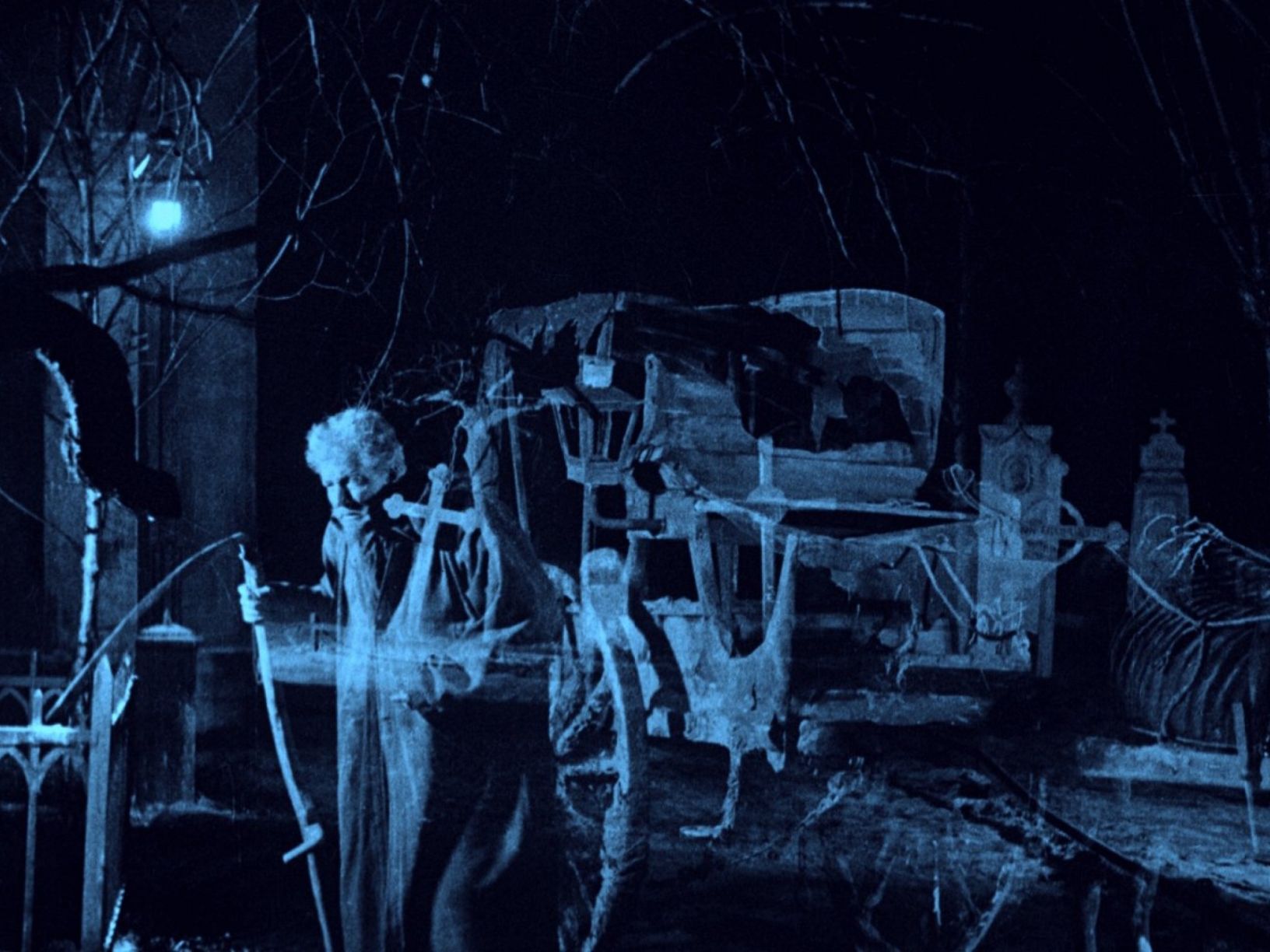I often say time is a film’s best friend and worst enemy. Victor Sjostrom’s 1921 The Phantom Carriage perfectly exemplifies this paradox. Upon its release, Charlie Chaplin cited the film as “The best film ever made,” calling Sjostrom “the greatest director in the world.”
Yet, here we are in 2023, and it’s a largely forgotten film, partially because silent films are rarely discussed. It is a pity, considering the wealth of talent, ingenuity, imagination, and emotion from that era. But Chaplin isn’t wrong in touting the towering achievement of The Phantom Carriage, a morality tale with a complex structure and a rich psychological landscape. With its eerie mood and deft emotional intelligence, Sjostrom tells a breathtaking story of death, love, and redemption.

Sjostrom’s script is an adaptation of Swedish author Selma Lagerlof’s “Korkarlen.” The book and films are inspired by an old Brittany folk legend that says the last person to die before the new year is doomed to drive Death’s carriage. Through Sjostrom’s sensitive rendering of the tale, this simple notion contains a multitude of implications.
Unlike most adaptations of the time, Sjostrom’s title cards contain minimal exposition. Often, silent adaptations would have swaths of the author’s prose in the title cards, but in The Phantom Carriage, he uses little to no excerpts from the book. Most of the title cards are essential dialogue, making The Phantom Carriage possibly a challenging watch. Yet, Sjostrom uses his actors as a vessel for the passages from the book, using the description and exposition not for the audience but as direction for his actors in a way that, while challenging, is no less easy to follow.
A lesser film would have told the story of David Holm, played by Sjostrom, linearly. But it’s how Sjostrom structures the film that makes it so effective.
We don’t see David happy and productive as his life rapidly deteriorates because of drink. Instead, Sjostrom plunges us at the end and zig-zags through time to give us the full scope of the man. We flash back and forth for narrative reasons and because seeing David at his worst brings the glances of David at his best into sharp, agonizing focus.
Sjostrom gives us visual clues and helps us by tinting scenes for night and day. He and editor Eugen Hellman help us from getting lost by ensuring that the past, present, or future we cut to takes place during the opposite time of day. This means we go from a scene during the day to a scene at night, letting us know we’ve moved to a different period as the movie weaves through time.
A prime example is how Sjostrom, Hellman, and Julius Jaenzon’s camera explain the story of Death’s carriage: David and his drinking buddies find themselves in a cemetery at night, the town clock nearing midnight. The scene is at night, tinted in a morse foreboding blue. David sees the time and tells his friends about the fable of Death’s carriage told him by an old drinking buddy, Georges (Tore Svennberg).
The film then cuts to a boarding house, tinted in sepia tone, but with shadows in the background indicating it’s a night in the past where we see David in the early stages of his alcoholism with Georges as they drink and play cards. Soon, the men get into a fight. Georges breaks up the fight and tells them the story about the driver of Death’s carriage.
Sjostrom then cuts back to the cemetery. Where the three men get into a fight and accidentally kill David. Death’s carriage arrives, driven by Georges.
The stark coloring of the film tells us we have traversed timelines. The way Sjostrom and Jaenzon light the scenes and how Sjostrom and Hellman cut them together makes the parallels evident. Sjostrom achieves this by shooting night-for-night, meaning he shoots outside, working with Jaenzon to create adequate lighting set-ups. In addition, the duo lit interior scenes that took place at night by using a spotlight as a light source to give the allusion of lamp light.

These little tricks help visually cue the audience to where and when we are in the complex structure. A structure that begins with Sister Edit (Astrid Holm) of the Salvation Army on her deathbed asking for David and ends with him on his knees begging for mercy from Georges at her deathbed. Sister Edit’s death is the throughline of The Phantom Carriage. The story ties the story together as she and David’s fates are irrevocably tied.
The Phantom Carriage explores Sister Edit’s unrequited love of the brutish David parallel with his wife Anna’s (Hilda Borgstrom) terror and disgust at him. Sister Edit is David’s salvation and is unwittingly responsible for Anna’s troubles.
The tale of David Holm is of an alcoholic suffering from tuberculosis. The character of David Holm is one of the biggest pricks in all of cinema. He is a hard-hearted man who is searching the countryside for his wife, who abandoned him while in prison, hellbent on revenge. Sjostrom plays David, seething with hatred for the world around him and himself.
Imprisoned for getting into a drunken brawl, he discovers that his brother, played by Einar Axelson, got drunk and killed a man. He feels remorse for this and his brother until he returns home to find his wife has left him and taken the kids and is thrown into a rage. Throughout The Phantom Carriage, David brags about consciously coughing into people’s faces, not caring if they get sick, eventually threatening to cough in the face of his children.
All of this is shown to us by Georges as he tells David he is now doomed to drive Death’s carriage for the following year. Sjostrom uses double exposure in one of the earliest representations of death onscreen, showing us a shabby carriage pulled by the skeletal remains of two long-dead steeds.
It is a haunting image, with the driver in a hooded cloak, their face hidden, as they collect corpses. Double exposure requires filming a scene with part of it blacked out, often using black curtains or objects, keeping portions of the frame from being exposed. Then, the film is re-wound to shoot a scene over the un-exposed portions to give a ghostly appearance.
We see Death claim the spirits of drowning victims of people who have committed suicide, all with the same stone-faced expression. All death is tragic, and the driver of Death’s carriage does not pass judgment as he goes about his duty. But that’s just the setting.
Technical mastery aside, it’s how Sjostrom and Hellman cut together scenes to allow the actors to give fleshed-out performances. Acting in silent films is often thought of as unrealistic and overly dramatic. In some cases, yes, but watching The Phantom Carriage, you begin to see how an actor’s face can tell you more than words and exposition can ever hope to capture.
The look of rage on Borgstrom’s Anna’s face as she sees Edit on her deathbed, responsible for helping David find her again, sends a chill down the spine. Her hands stretched as she fights the urge to strangle the woman.
Sjostrom expertly relays all the visual information not because of the complex structure but because of the complex relationships. The way every character seems less a character than a whirlwind of conflicting emotions makes them all the more alive and timeless. But he also understands how best to use a camera to frame an actor and get the best from them.

Sister Edit’s look of lust at the rumpled David, the pitiful sorrow on David’s face as he realizes his wife doesn’t believe he’s repented and has reasonable cause to, the mournful look of surprise on Georges’ face when he sees David’s spirit in the cemetery, all are the embodiment of the purpose of cinema-to capture truth in the human face,
Sjostrom’s script is filled with allegory and sidesteps symbolism. Lagerlof’s story might be one of alcoholism, but Sjostrom uses tuberculosis less as a disease and more as a way to show a broken individual. The characters who contract tuberculosis in The Phantom Carriage are souls marred and hardened by the world bent on spreading as much pain as possible. He effectively uses the disease to show how hatred can breed and spread, damning all it touches.
This is why the scene where drunk David threatens to cough in his sleeping child’s face feels so violent, both literally and metaphorically. It is the cycle of abuse. The act makes David’s redemption feel so doubtful, as Sjostrom has shown us a truly heinous act from a man whom it is impossible to tell whom he hates more, the world or himself.
But Sjostrom isn’t interested in easy platitudes. Yes, David inevitably repents, but the scene in which he does so is heartbreaking because Borgstrom’s Anna is so reluctant to believe him, and that trepidation is the final realization for David of how much pain he has caused. The scene feels ripped from a nightmare of the soul.
The way Sjostrom and Jaenzon so effortlessly capture this exchange through looks instead of a title card shows a mastery worthy of Chaplin’s praise. Hellman’s cuts keep the scene taut, clutching us by the lapels and forcing us to watch.
Sjostrom’s technical achievements are easy to miss because they are so subtle. He has such a precise understanding of visually telling a story that he can break the foundational rules of cinema. Even rules that he himself mastered, such as the one-eighty rule, a sacred rule of filmmaking wherein actors in the same scene have the same left/right relationship with each other.
The hard and fast rule is vital to much of cinema, especially silent cinema. For even as Sjostrom violates this rule, we are never lost, proving that as crucial as the rule may be, breaking it does not inherently mean bad filmmaking. Often quite the contrary, consistency is the hobgoblins of little minds and all that.
The Phantom Carriage never feels its age. Sjostrom’s morality tale is more humanistic than pious, as he mines the heartbreak of existence.
Images courtesy of AB Svensk Filmindustri
Have strong thoughts about this piece you need to share? Or maybe there’s something else on your mind you’re wanting to talk about with fellow Fandomentals? Head on over to our Community server to join in the conversation!

